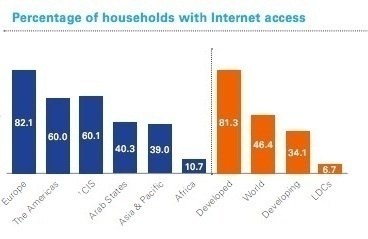According to the data submitted by wireless users, the demand for connectivity has resulted in the growth of Wi-Fi hotspots throughout the world, especially in the United States.
Nowadays, there is a high demand for wireless network across the world and based on user submitted information collected by WiGLE (website for collecting information about the different wireless hotspots around the world), the dominant continents for wireless networks are Europe and North America. The United States is listed as a world leader with more than 50 million wireless networks followed by Germany with approximately 9 million.
As shown on the map below, there is a notable distinction between the amount of wireless networks in the metropolitan and rural areas in the US. The West Coast states with the most identified wireless networks are California, with more than 6 million public Wi-Fi networks, and Texas, while on the East Coast, New York state overshadows the other areas with more than 2 million WLANs.

Source: mymodernmet.com
Furthermore, although the US is a global leader in number of Wi-Fi networks, it did not rank in the top 20 list of the 184 countries surveyed for public WiFi download speed. Whereas, in terms of the quality of public WiFi networks, Europe is dominant. The quality of public WiFi networks is distinct in every location and elements of connectivity such as: access points, distribution systems, wireless mediums, etc. vary from place to place. A survey conducted by Rotten WiFi revealed Lithuania as a leader in the top 20 countries with best public WiFi networks. The quality of the country’s Wi-Fi connections is measured by the number of Mbps (the average download speed). For instance, Lithuania’s average download speed is 16.1 Mbps, followed by Estonia with 14.8 Mbps. Source: mymodernmet.com
Check out the survey results here.
On the other hand, with regards to wired private networks across the world, Europe has the biggest percentage of households with Internet access. Based on the results from the survey conducted by an International Telecommunication Union (ITU), Europe has 80% of its households with Internet access, while the Americas have 60%, followed by the Arab states with 40% and Africa with only 10%.
 |
| Source: ITU Facts & Figures |
Based on the aforementioned surveys in relation to the number of wired and wireless networks worldwide, the demand for connectivity is high in Europe, the Americas and CIS. Correspondingly, Wi-Fi public hotspots throughout continental Europe and the US grew both in quality and quantity. The connectivity of principal countries is highly satisfactory in comparison to Africa, which is currently far behind in terms of both-wireless network deployment and a process of getting wired.
Related Articles:

